Hey, Do you Know? Agriculture in India illustrates the country’s resilience and innovation because it is deeply rooted in cultural traditions and feeds a large portion of its population.
Agriculture sector, employs over 600 million people, exemplifies the diversity of India’s climate and terrain, from the stunning Himalayas to the lush Gangetic plains, providing a backdrop for a wide range of crops and farming activities.
Agriculture in India: At A Glance
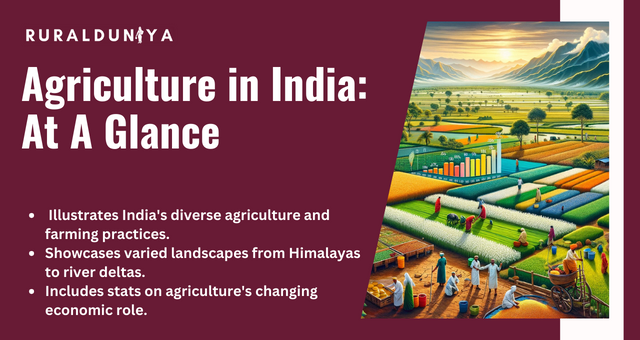
Agriculture in India share country’s total income, as indicated by the Gross Value Added (GVA), has declined in recent years. In 1990–1991 it was 35%; in 2022–2023 it is just approximately 15%.
The reason for this change is that other sectors of the economy, such manufacturing and services, are now more profitable than agriculture. In 2023, there were about 148 million workers in the agricultural sector.
But in 2022, there were more people working in agriculture—more than 158 million people.
India’s agricultural landscape is as diverse as its cultural history, stretching from the chilly Himalayan peaks to the lush deltas of the south. The country’s diversified geography, spanning more than 3.2 million square kilometers, is perfect for a wide range of crops and farming methods.
This diversity is evident in agriculture, which employs 58% of the Indian population and is the backbone of the country’s economy and civilization.
The sector’s size is evident in its global leadership in milk production, with 250.58 million tonnes produced in 2022-23, as well as its significant contributions to the world’s supply of rice, wheat, pulses, and cotton.
They all highlighting India’s critical role in feeding not only its own population but also contributing to global food security.
History of Agriculture
The story of Indian agriculture is deeply interwoven in the country’s history, stretching back to the intricate agricultural systems of the Indus Valley Civilization.
Over millennia, these traditions have been perfected, preserved, and passed down through generations, leaving a rich legacy of farming expertise.
The Green Revolution of the 1960s and 1970s marked a watershed event, introducing high-yield crop varieties and better irrigation methods, resulting in an exponential increase in food production.
Food grain production has risen from 82 million tonnes in the early 1960s to 309.34 million tonnes by 2023-24, transforming India from a country beset by food scarcity to one known for agricultural plenty and self-reliance.
This period not only changed Indian agriculture, but it also established the framework for future advances and breakthroughs in farming operations.
Agriculture Technology: Modern Farming
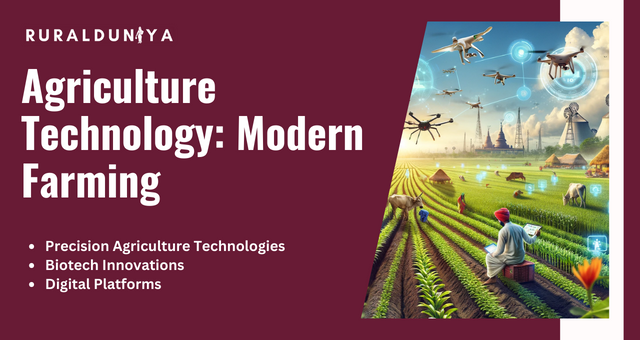
Advancements in technology and infrastructure are key to India’s next phase of agricultural expansion.
- Precision Agriculture Technologies: Implementing GPS, IoT, and remote sensing technologies can improve agricultural management, leading to higher yields and more efficient resource use.
- Biotech Innovations: Genetically modified crops and CRISPR technologies can boost crop resilience and yields, resulting in higher agricultural production.
- Digital Platforms: By leveraging AI and machine learning, farmers can have access to market information, predictive analytics, and best farming practices, hence boosting decision-making and market access.
List of Agriculture Schemes
Indian government has initiated numerous agriculture schemes to assist farmers and enhance agricultural productivity.
- E-NAM (National Agriculture Market): It links various local markets where farmers sell their produce, making it easier for them to reach clients across the country. It was introduced by the government in 2016 to help farmers get paid more for their produce.
- Pradhan Mantri Kisan Maan-Dhan Yojana (PM-KMY): It intended to help small-scale, low-income farmers as they get older. Farmers who own a small plot of land for farming and are between the ages of 18 and 40 are eligible to take part in this program.
- Pradhan Mantri Krishi Sinchayee Yojana (PMKSY): Aims to improve irrigation coverage (“Har Khet ko Pani”) and water efficiency (“More crop per drop”), hence promoting sustainable water resource management in agriculture.
- Paramparagat Krishi Vikas Yojana (PKVY): Government plans to establish 10,000 clusters and convert five lakh acres to organic farming, with financial incentives of INR 20,000 per acre over three years for participating farmers.
- Pradhan Mantri Fasal Bima Yojana (PMFBY): Insures farmers against natural disasters, stabilizes income, and encourages new agricultural methods.
- Program for Soil Health Cards (SHC): It helps farmers assess whether the nutrients in their soil are sufficient to promote the growth of healthy crops. It was introduced in 2015 and teaches farmers how to boost crop development by applying the right soil amendments.
- National Bamboo Mission (NBM): It aims to increase the amount of bamboo grown in India, enhance bamboo products, and increase employment possibilities. This was started in 2018 with the intention of helping farmers and those working in the bamboo sector.
These programs aim to give comprehensive support to the farming community, ranging from financial assistance to technical access, in order to ensure Indian agriculture’s long-term viability and expansion.
Rainbow Revolution: Promoting Agricultural Diversity
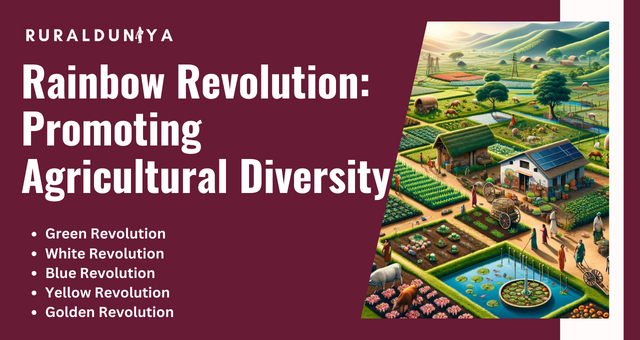
Building on the success of the Green Revolution, the Rainbow Revolution seeks to diversify and enrich Indian agriculture.
- Green Revolution: It has strengthened India’s status as a premier wheat and rice producer.
- White Revolution: It brought India to the forefront of global milk production.
- Blue Revolution: It enhanced fishing production in India, benefiting worldwide fisheries.
- Yellow Revolution: It attempted to enhance oilseed production, namely soybeans and mustard, to meet domestic and international demand.
- Golden Revolution: It sought to expand horticulture and honey production, broadening India’s agricultural output.
This comprehensive approach maximizes India’s agricultural potential while also ensuring food security and stimulating economic growth through diversification.
Issues in Indian Agriculture: Addressing Challenges
Agriculture in India despite substantial growth, still confronts a number of key challenges:
- Yield and Water Management Challenge: With India’s cereal yield of 3,300 kg per hectare, which is lower than the global average, and effective water management, especially in rain-dependent areas, is critical to sustainability.
- Rural-urban gap: It remains, creating a barrier to equitable agricultural expansion. Access to resources and opportunities remains unequal across regions, impeding inclusive development.
- Access to Agricultural Technology Barrier: Many small-scale farmers lack access to modern agricultural inputs and technology. Improved infrastructure and training are critical to boosting productivity and profitability.
- Limited market access and price fluctuations: Farmers have challenges due to limited market access and price fluctuations, which leads to income volatility. Improving market integration and implementing price stabilization techniques are crucial.
Furthermore, investments in modern storage, cold chain, and logistical facilities are crucial for decreasing post-harvest losses and ensuring the efficient distribution of agricultural produce, which has a direct impact on farmers’ earnings and market pricing.
A Recap of Findings
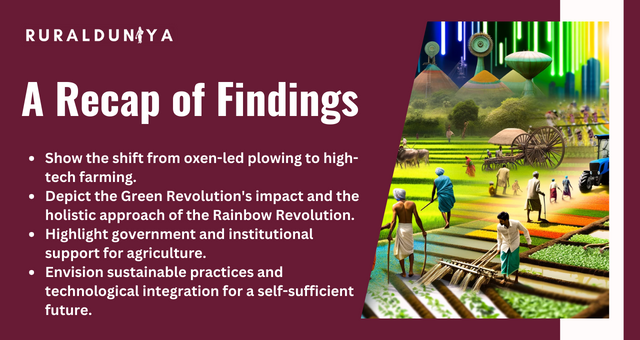
The tale of agriculture in India, from traditional practices to the revolutionary Green Revolution and the ongoing Rainbow Revolution, is one of tenacity, innovation, and teamwork.
As the sector develops, the combination of traditional wisdom and modern technology, assisted by government initiatives, will be important in addressing present challenges.
This collaborative approach aims to ensure national food security while also contributing to global food sustainability, ushering in a future in which Indian agriculture is both self-sufficient and a global agricultural leader, driving prosperity and sustainability for future generations.
FAQs
Who is the father of agriculture in India?
Mankombu Sambasivan Swaminathan is frequently referred to be India’s “father of farming.”
What is Indian agriculture?
India is a great place to farm since we produce world-class milk, pulses, and jute. We also raise a wide variety of delicious vegetables and fruits, as well as rice, wheat, and sugarcane.
Which crop was first grown in India?
People started cultivating barley and wheat a long time ago (about 8000-6000 BC).
What are 4 types of agriculture?
Consider the following farming methods: shifting farming (where you move about), farming for what you need, animal care (like with shepherds), and intense farming.
What is the rank of India in agriculture?
India is amazing at farming. We are the world’s second-largest producer of rice and wheat, and first in pulses.
What is the national crop of India?
Rice is the main crop here. It is so important to us that we consider it one of our national crops.
Which state has richest farmers in India?
When you hear about wealthy farmers, you usually think of Meghalaya, Punjab, and Haryana. They have some fairly successful farmers, thanks in great part to enough land, water, and government support.

Nishank is a social impact enthusiast with a solid foundation in public policy, micro-enterprise, and agribusiness. Growing up in a farmer’s family has given him a profound connection to rural communities, fueling his passion to empower people towards self-reliance. He completed his undergraduate studies at the Delhi University and earned a master’s degree in Rural Management from National Institute of Rural Development & Panchayati Raj in Hyderabad.

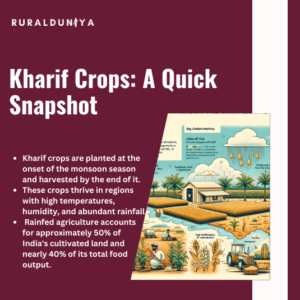
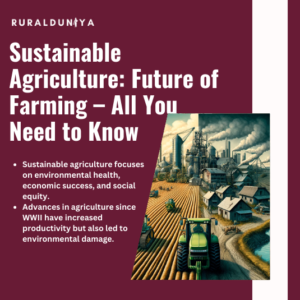
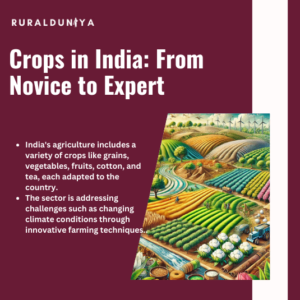
For the reason that the admin of this web site is working, no uncertainty very soon it will
be famous, due to its quality contents.